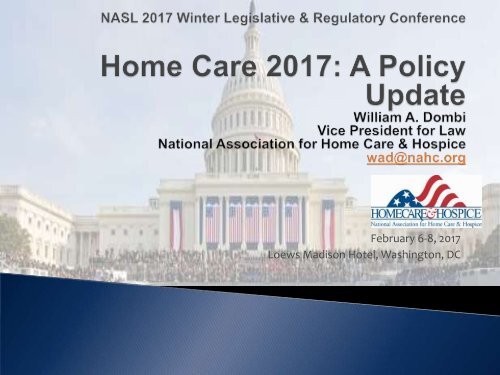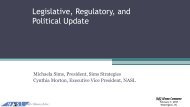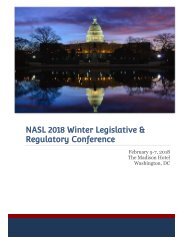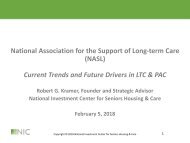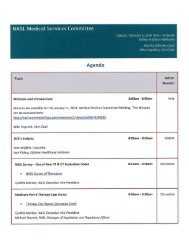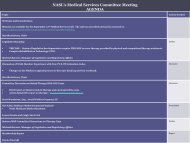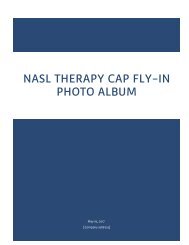Dombi - winter 2017
You also want an ePaper? Increase the reach of your titles
YUMPU automatically turns print PDFs into web optimized ePapers that Google loves.
February 6-8, <strong>2017</strong><br />
Loews Madison Hotel, Washington, DC
New Opportunities<br />
◦ Regulatory reversals<br />
• FLSA rules: companionship services; live-ins; OT<br />
• Medicare policies: F2F; preclaim review; new<br />
Conditions of Participation<br />
◦ Obamacare: Employer mandate: block penalties?<br />
New Risks<br />
◦ Medicaid block grants<br />
◦ Medicare reform<br />
• Premium support (defined contribution)<br />
• Single cost sharing under PART A AND Part B<br />
• Would mean home health and hospice cost sharing<br />
◦ Spending cuts<br />
•
Post-Acute Care Value-Based Purchasing<br />
◦ House Ways and Means<br />
• Level of financial risk<br />
• Measures used in scoring performance<br />
Chronic Care Management<br />
◦ Senate Finance Committee<br />
• Focus on MA Plans<br />
• Opening telehealth somewhat<br />
• Hospice integration with MA not included
Home care impact:<br />
◦ Telehealth study<br />
◦ Home Infusion therapy benefit (2021)<br />
◦ Medicaid electronic visit verification<br />
• Personal care (2019)<br />
• Home health services (2023)<br />
◦ Moratoria application to service area
Permit Non-physician Practitioners to certify<br />
Medicare home health eligibility<br />
◦ Home Health Care Planning Improvement Act of 2015<br />
H.R.1342, S.578(2016)<br />
Extend Medicare Home Health Rural Add-on<br />
◦ S.2389 (2016)<br />
Reform Medicare Face-to-Face documentation<br />
requirements<br />
Suspend Medicare Pre-claim Review
MedPAC <strong>2017</strong> March Report to Congress – Most Medicare<br />
provider types assessed for payment adequacy<br />
HOME HEALTH:<br />
2015 average margin: 15.6% (11.1 est. <strong>2017</strong>)<br />
Access to care<br />
◦ 12,346 HHAs (-115 since 2014)<br />
Capital OK<br />
RECOMMENDATIONS:<br />
5% cut in 2018<br />
Elimination of therapy utilization as a payment level<br />
determinant under HHPPS<br />
The institution of a second round of rate rebasing in 2019<br />
National Association for Home & Hospice<br />
Care 2016 6
HHPPS <strong>2017</strong> Final rule<br />
Rates<br />
Value-Based Purchasing pilot<br />
Program Integrity/Claims Reviews<br />
New CoPs (effective 7/13/17)<br />
Star Rating System
<strong>2017</strong> Rates<br />
◦ Overall -1.53% rate reduction compared to 2016<br />
New Outlier eligibility standards<br />
◦ Based on 15-minute service units<br />
Case mix weight recalibrations<br />
Modifications of HHVBP measures<br />
New Negative Pressure Wound Treatment benefit<br />
Status report on IMPACT Act measures
New model intended to address:<br />
◦ Access to care for vulnerable patients<br />
◦ Elimination of therapy volume as payment rate<br />
determinant<br />
Home Health Groupings Model (HHGM)<br />
◦ 128 payment groups<br />
◦ Episode timing: early or late<br />
◦ Admission source: community or institutional<br />
◦ Clinical grouping: 6 groups<br />
◦ Functional level: 2-3 groups<br />
◦ Comorbidity adjustment: secondary diagnosis based
Notables<br />
◦ Therapy volume domain eliminated<br />
◦ Cost per minute + NRS approach to resource use<br />
◦ 30 day periods within 60 day episode<br />
• First 30 is an “early” period, all others are “late”<br />
◦ Admission source (14 days prior to early episode)<br />
• Community vs institutional<br />
◦ Six clinical groups<br />
• Musculoskeletal rehabilitation; neuro/stroke rehabilitation/wounds;<br />
complex nursing interventions; behavioral health; and medication<br />
management, teaching and assessment<br />
◦ OASIS-based functional analysis M1800-1860 + M1032<br />
◦ Regression analysis (2013 base)<br />
◦ What happens to RAPs, LUPAs, and outliers???
Timing of implementation TBD<br />
◦ Needs adjustments such as ICD-10<br />
Will go through public comment rulemaking<br />
Industry needs to model the impact<br />
◦ Expected to lower payment rates on therapy episodes,<br />
increase rates on high nursing volume cases<br />
◦ Geographic impact<br />
CMS held an Open Forum on 1/18/17<br />
https://blh.ier.intercall.com/details/87624e33054740<br />
8593456b114011de08
•CMS pilots a VBP:<br />
– Started in 2016<br />
• Baseline year 2015<br />
• Performance year 2016<br />
• Payment year 2018<br />
– 9 states mandatory participation of all HHAs<br />
– 3-8% payment withhold for incentive payments<br />
• “greater upside benefit and downside risk”<br />
• Phase-in to 8%<br />
– performance measures<br />
• Achievement and improvement<br />
• Process, outcomes, and patient satisfaction<br />
• Baseline data released in April; first HHA quarterly report in late<br />
July
Generally supportive of VBP as a payment model reform<br />
◦ Details matter!<br />
Details here raise concerns<br />
◦ Amount at risk<br />
• 2% is max in other sectors<br />
• At risk levels may prevent improvements as resources depleted<br />
◦ Measures are complex, subject to manipulation, and leave out<br />
patient stabilization<br />
• Do not reflect chronic care population served in home health<br />
◦ Will overlap with bundling, ACOs, and other innovations<br />
◦ Benchmarks based on all patients with OASIS, not just Medicare<br />
FFS
Now calculating benchmarks and achievement<br />
thresholds at state level<br />
◦ Too few ”small” HHAs<br />
Apply VBP based on large vs. small HHAs, but only if<br />
at least 8 in the cohort<br />
Drops 4 measures that were not needed or not<br />
ready<br />
Establishes appeals process<br />
Submission process/timetable changes
Combined PAC VBP<br />
Controversial first versions<br />
Version 3<br />
◦ budget neutral in the aggregate<br />
◦ MSPB, Discharge to community, and preventable readmission<br />
measures<br />
• Optional quality measures<br />
◦ Two-track risk model<br />
• 2-5% at risk (high risk track)<br />
• 1-2% at risk (low risk w/ other VBP involvement, e.g. HHVBP)<br />
Reduced base rates with performance bonus<br />
opportunity<br />
Industry concerns<br />
No Senate counterpart (yet)
New benefit effective 1/1/<strong>2017</strong><br />
Alternative to DME wound vac<br />
Disposable device<br />
Covered under Part B as outpatient service<br />
item/service<br />
HHA is only eligible provider<br />
Requires home health benefit eligibility<br />
Permits concurrent HH and OPS payments
IMPACT Act driven<br />
New Measures<br />
◦ MSPB-PAC HH QRP<br />
◦ Discharge to Community-PAC HH QRP<br />
◦ Potentially Preventable 30-Day Post-Discharge Readmission<br />
for HH QRP<br />
◦ Drug Regimen Review conducted with Follow-Up for<br />
Identified Issues-PAC QRP<br />
Still open to considering socio-economic status as<br />
factor in risk adjustment<br />
Potential measures for PAC VBP
Combines outcome measures and process measures<br />
from Home Health Care Compare into a single score<br />
https://www.cms.gov/Medicare/Quality-Initiatives-<br />
Patient-Assessmentinstruments/HomeHealthQualityInits/HHQIHomeHea<br />
lthStarRatings.html<br />
Star Rating Concerns<br />
Focus on Improvement measures<br />
Formula pushes scores to the middle<br />
Most HHAs with 3 Stars<br />
Consumer impression that 3 Stars is mediocre<br />
Patient experience (HHCAHPS) Star rating a different model<br />
More traditional design<br />
Consumer familiarity with model
MA plans have begun auditing home health claims on a post-pay basis,<br />
including MI<br />
Some using a contractor: SCIO<br />
Focus on technical compliance issues<br />
◦ Signed physician orders<br />
◦ F2F requirements<br />
◦ Pre-2015 therapy needs assessments<br />
◦ OASIS<br />
HHAs not aware that MA plans required compliance with technical Medicare<br />
FFS standards<br />
Significant back liabilities<br />
Costly appeals processes
Three-year, five-state demonstration; started in Illinois with episodes<br />
beginning August 3<br />
◦ Florida, Texas, Michigan, and Massachusetts may be phased in through<br />
<strong>2017</strong>)<br />
CMS announced expansion into Florida effective April 1, <strong>2017</strong><br />
MAC review for Pre-claim review<br />
◦ All claims processed as complex medical review<br />
◦ HHA can start care and receive RAP<br />
◦ If submitted for pre-claim review and approved, claim paid<br />
◦ If submitted for PA and denied, denied (may appeal)<br />
◦ If no PA submission but claim submitted and approved, 25% reduction in<br />
payment (3 month grace period)<br />
Illinois experience difficult; recent improvement in affirmation rate to over<br />
90%<br />
◦ HHAs reduced documentation errors<br />
◦ Focus on physician documentation<br />
◦ Improved MAC performance<br />
20
Suspension/rescission of pre-claim review by the<br />
incoming Administration.<br />
Introduction of legislation to suspend pre-claim review<br />
in the upcoming 115th Congress in the House and Senate.<br />
Development of a lawsuit to challenge the legal validity<br />
of the project.<br />
Initiation of a major provider education effort.<br />
Establishment of standards for CMS to scale back the<br />
application of pre-claim reviews to target only high risk<br />
providers and that rely on random sampling<br />
methodologies for pre-claim reviews overall in order to<br />
reduce unnecessary administrative burdens.
• Civil Money Penalties (CMP)*<br />
• Suspension of payment on new admissions*<br />
• Temporary management*<br />
• Directed plan of correction**<br />
• Directed in-service training**<br />
• * required by statute<br />
• ** required by regulation
2016<br />
◦ 4,976 HHA surveys<br />
◦ 2.5% with condition-level deficiency<br />
◦ CMP sanctions—79<br />
◦ Suspension of payment on new admissions—30<br />
◦ Directed plan of correction—5<br />
◦ Directed in-service training—11<br />
◦ Temporary management--1
Final Rule<br />
Federal Register 1/13/<strong>2017</strong> (proposed<br />
10/7/14)<br />
◦ https://www.federalregister.gov/docume<br />
nts/<strong>2017</strong>/01/13/<strong>2017</strong>-00283/medicare-andmedicaid-program-conditions-ofparticipation-for-home-health-agencies
First major revision in CoPs in 3 decades<br />
Provides an outcome oriented, flexible, patientcentered<br />
focus<br />
$293M annual cost<br />
◦ Accredited HHAs less since many have systems in place<br />
already<br />
Major changes<br />
◦ QAPI<br />
◦ Infection control<br />
◦ Patient Rights
Standard –Transfer and discharge NEW<br />
The patient and representative (if any),have a right to be informed of the<br />
HHA’s policies for admission, transfer, and discharge. The HHA may only<br />
transfer or discharge the patient from the HHA if:<br />
1) acuity requires another level of care—HHA must arrange for<br />
safe and appropriate transfer<br />
2) no payment<br />
3) physician and HHA agree that goals met<br />
4) patient refuses care or elects transfer/discharge<br />
5) cause – disruptive, abusive, uncooperative behavior;<br />
i) advise patient, physician etc. of the plan to d/tr<br />
Ii) efforts to resolve problems prior to d/tr<br />
iii) provide patient with contact information for other<br />
agencies/providers<br />
iv) document efforts made to resolve issues<br />
6) death<br />
7) HHA ceases to operate
Request that CMS withdraw CoPs or extend<br />
compliance deadline<br />
◦ High cost to implement and administer w/o clear ROI<br />
◦ Insufficient time to properly implement<br />
◦ New administration regulatory freeze/suspension
CMMI pilots/demos continuing<br />
◦ 2100 participating providers in 360 demo agreements<br />
– Limited home health participation; virtually no risk taking<br />
– ACO experience shows some home health gains in use<br />
– CMS Joint Replacement Bundling<br />
– Home health impact: mixed, but mostly positive in the<br />
aggregate
Rule changes directly and indirectly targeting home care<br />
◦ “companionship services” exemption<br />
◦ Live-in domestic services<br />
◦ Professional, executive, and administrative salaried<br />
employees<br />
Policy positions informed through home care<br />
◦ Joint employer<br />
◦ Independent contractor<br />
DoL Sleep Time Guidance<br />
DoL New Audit Focus on mileage reimbursement
Industry retrenches to limit worker hours and<br />
establish new delivery models<br />
Turnover increases<br />
Home care company costs increase<br />
Client costs increase with some reducing care<br />
levels<br />
Industry effort to restore FLSA exemptions to pre-<br />
2-15 standards combined with efforts to improve<br />
funding for caregiver compensation
Election results raise speculation to a new level<br />
Moderately stable times<br />
Opportunities for innovation<br />
Challenges remain in regulatory proposals/changes<br />
Quality remains high, but standards and oversight on the<br />
increase<br />
Manage today, plan for the future!


